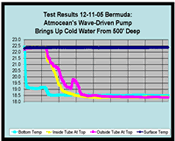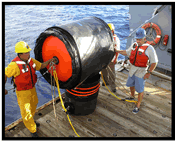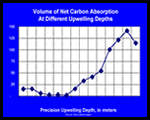  
|
Our
technology uses kinetic wave energy to bring up higher-nutrient
deep water. In the presence of sunlight, and assuming
appropriate ocean environmental conditions, the enhanced
nutrients generate blooms of phytoplankton
which absorb dissolved CO2 and generate oxygen through
the process of photosynthesis. When the phytoplankton
are consumed by higher trophic levels such as zooplankton
and fish, or when the phytoplankton die, some of the
absorbed CO2 as well as other biochemical contents sink.
Some of this is remineralized and suspended in mid ocean
depths, some sinks to the ocean floor, and some is sent
back up to the surface by natural upwelling events (currents,
storm-generated upwelling, heating/cooling cycles such
as El Nino, etc.). This "biological pump" is
the principle physical process responsible for the higher
concentrations of nutrients, and CO2, which are found
beneath the upper sunlit zone (typically 50 to 80 meters)
of the ocean. Within the upper ocean's sunlit zone,
however, the nutrients are quickly consumed, with the
result that phytoplankton blooms diminish until upwelling
brings up more nutrients.
Until recently, conventional wisdom regarding limits to phytoplankton productivity
in the upper sunlit zone of the ocean cited the Redfield Ratio as the limiting
factor to how much net benefit could accrue from wave-driven ocean pumps. The
Redfield Ratio limits the amount of carbon that each phosphate atom can recycle. For
the average of all the ocean is it 106 carbon atoms for every phosphate atom.
If CO2 recycling efficiency is limited by phosphate, and deeper water contained
proportional concentrations of nitrate, phosphate and dissolved CO2, then net
additional absorption from upwelling of phosphate would be balanced by the higher
concentrations of CO2 brought upward - at best a zero sum game.
But Professors David M. Karl from University of Hawaii, and Ricardo Letelier
from Oregon State University have recently published a peer-reviewed paper which
hypothesizes that upwelling of certain deeper waters (generally 300m or more)
can result in a secondary bloom governed by nitrate as the limiting nutrient
- with the result that several-fold greater net absorption of CO2 is possible.
The absence of nitrate causes diazotrophic (nitrogen fixing) phytoplankton to
dominate the second bloom, with super-Redfield C:P ratios of >200:1. Click
this link to read their paper.
Given this new Karl-Letelier hypothesis about potential net sequestration of
CO2, if ocean biogeochemical conditions are suitable for generating primary
and secondary blooms, and given the potential for a single Atmocean pump to produce
nominal upwelling volume of 200,000 cubic meters per day (consistent with 3 meter
wave height), initially we estimate precision upwelling could result in net additional
sequestration of about 60 tons CO2 per pump per year, with the significant added
benefit of 1.5 tonnes annual increase in fish biomass. Many elements of this
process remain to be tested, including the multiple effects over many seasons
and in different ocean environments, and how the upper, mid, and deep-ocean concentrations
of nutrients and CO2 could transition over longer time periods.
To initiate testing of the Karl-Letelier Hypothesis, in May 2008 Atmocean participated
in an ocean test of three pumps in the Pacific about 60nm north of Hawaii. This
test is featured on the Discovery Channel Project Earth episode "Hungry
Oceans". To order the DVD set of all eight Project Earth episodes, visit
the Discovery Channel store, or contact Atmocean to purchase a DVD of just the "Hungry
Oceans" episode. In brief, while not all the experimental goals were achieved
(due to structural failures, and an inappropriate pump deployment method), the
tests conclusively proved our capability to pump up nutrient-rich water from
300m deep in the open ocean, solely using wave energy. Since we learn more from
failure than success, these tests prompted a new durable pump design for extreme
ocean conditions. We expect this new design, which very closely mimics natural
ocean mixing processes, can be produced and deployed at equal or lower cost than
our "original" design. If comprehensive future testing demonstrates
that the environmental consequences are manageable and achieves permanent, additional,
net CO2 absorption in the oceans, this could lead to large-scale commercial implementation.
*U.S.
and International Patents Pending
To
discuss in more detail how Atmocean’s technology
might accelerate the oceans’ uptake of CO2, please
contact Philip W. Kithil, CEO, at [email protected]
|